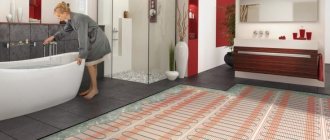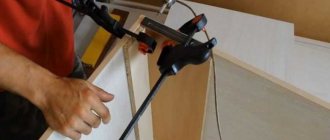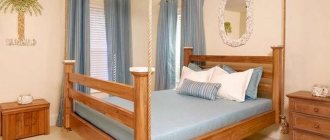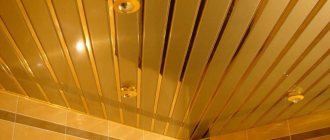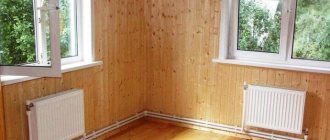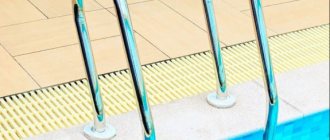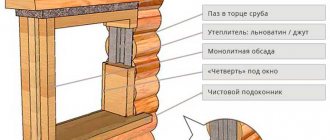Everyone knows the common heating methods: underfloor heating and installing radiators. However, there is another unusual option - a warm water baseboard. This option cannot yet be called very widespread, but nevertheless it is worth taking into account, because it combines the advantages of two types of heating at once: radiators and heated floors. Warm baseboards are now used to heat administrative and office buildings, residential buildings and apartments.
Baseboard heating
Despite the fact that in our country what a warm baseboard is became known not so long ago, in Europe premises have been heated using this method for several decades. This technology is very simple, but at the same time quite convenient. The basis is metal (most often copper) pipes, which are also the heating element. The pipes are installed in the same place where the baseboard usually runs, that is, along the perimeter of the room. Then they are covered with a metal box made of plates with a corrugated surface. Due to this design, the box acts as a heat exchanger, thereby increasing the efficiency of the structure.
In general, a water baseboard consists of the following elements:
- front panel with holes that ensure air flow (standard size: width - 3-4 cm, height - 15-20 cm);
- rear panel - facilitates installation of the structure and protects the wall from constant exposure to high temperatures;
- heating radiator that performs the heating function (standard dimensions - 1 m x 0.4 m x 1.6 m);
- rotating side plugs;
- a heat exchange module consisting of two tubes through which water circulates.
Currently, there is a variety of warm baseboards (electric.) They differ from warm water baseboards only in the type of heating element.
Due to the fact that the baseboard is installed around the perimeter of the entire room, the heat gradually rises, and then the entire room is evenly heated. As a result, this technology does not cause temperature changes. Since the heating element is hidden under the front panel, it is not noticeable, which distinguishes it from massive radiators. As you can see in the photo, the warm baseboard looks very neat; it can be additionally decorated so that it better matches the overall style of the room. The system is effective, but at the same time quite simple to install. Having minimal skills, you can carry out installation without involving professionals.
Warm baseboard: Anyone can make a budget heating system with their own hands - Instructions + Video
Warm baseboard - budget heating system with your own hands. One of the main factors for comfortable living in a home is the temperature inside the room. There are many types of heating systems. One of them is a warm baseboard, a relatively new type of heating.
The good thing about it is that you can make it yourself. With a wide range offered by manufacturers, prices for the structure itself and its installation can be steep.
Therefore, the budget option, “do-it-yourself warm baseboard,” is more preferable.
General information
The compact design does not reduce its effectiveness. The time required for design and installation is the same as for installing standard radiators. Masking the heating parts with an aluminum profile, such a plinth does not spoil the interior of the apartment. It has low sides and evenly distributes the heat that flows along the floor and walls of the room.
There are two types of baseboards, which differ in the type of coolant (water, electricity) and, accordingly, structural elements and connections.
Review of warm skirting boards
Electric warm baseboard
From the beginning, insulating tape is glued along the level of the bottom bar. Then there are metal brackets, on which there is a heating module made of copper tubes connected by brass fins in a heat exchanger. The front panel can be of any color. The factory heat exchanger consists of plates. They are the most expensive material of construction. If you replace the plates with pipes, you can save a lot.
The design of a factory plinth consists of a large number of elements. This is a heat exchanger, elbow, plugs, profiles and much more. To make a warm baseboard with your own hands, you will need a set of self-regulating heating cable EHL30-2CR RST. It can change resistance depending on temperature changes. Operating temperature from -40 to +65, maximum +85 degrees. Power 35 W per linear meter at a temperature of zero degrees.
The footage must be taken with a reserve. A set of heat-shrinkable tubes for connecting the cable and electrical plug. Corrugated stainless steel pipe. Its thermal conductivity is less than that of copper, but better than plastic. Ceiling guide profiles plus self-tapping screws, mounting tape and brackets.
Reference! Insulation can be used NPE-LF type C with a coefficient of surface thermal reflection of 97% with water absorption in 24 hours of 0.94% moisture. 5 mm thick.
We prepare the heating cable. We weld the end with special heat-shrinkable tubes. We connect to the power supply and check. Turn it off and carefully put on the corrugated tube. After half an hour we look at the heat transfer. If everything is in order, we begin installing the plinth indoors.
We lay a pre-prepared corrugated cable around the entire perimeter of the room, look at the dimensions again, and modify if necessary. We glue insulating tape to the wall where we install the structure. Insulation pre-cut into strips 6-8 cm wide. We mount an aluminum ceiling profile from the corner, securing it with self-tapping screws.
Next, we lay a corrugated tube with a cable into it and secure it with staples. This version of a warm baseboard is suitable for heating a garage or veranda. For premises in a residential building, it is necessary to provide a top panel. It can be any color you like without spoiling the design.
Reference! When using a self-regulating cable, you do not need to use sensors and heat regulators.
The entire project will cost between 500-600 rubles per linear meter. If you purchase a heating cable of lower power, the price will decrease significantly. You can also use a metal sleeve.
Water warm baseboard
The technology of operation and production of warm water or liquid baseboard is simple to implement. The heating element here is water or a special liquid. And the heater is the boiler. The system is cyclical, that is, water is supplied to the radiators and returned back to be reheated. The boiler is equipped with a thermostat.
Reference! Any type of boiler is suitable for this type of heating. Gas, electric and even coal/wood.
The simplest and most cost-effective solution for a warm water baseboard is to take a galvanized plumbing pipe 15mm in diameter. Using a welding seam using the “point” method, grab a sheet of iron, bend it in advance along the required radius and weld the perimeter with a continuous seam.
Cover the top with paint. Or run 4-6 pieces of half-inch stainless corrugated pipe along the baseboard using the same technology. This will help remove excess moisture. It will prevent mold and mildew from forming in corners and on walls.
A more expensive way to make a warm baseboard is to purchase a copper roofing strip and pipes of a suitable diameter. We cut the strip into pieces of the required size. We connect with a gas burner. We form a continuous line and mount it to the wall using insulation clips. We fill the entire system with liquid material, having previously connected it to the collectors and the boiler.
The copper plinth can be painted if desired, but it will look noble even with a natural color. This method can be used in residential premises.
Attention! For any construction, electrical, or gas-electric welding work, it is advisable to contact specialists.
Characteristics
The warm baseboard heating system is very well suited for buildings with poorly insulated walls, in log houses, for example. The heat from the baseboard will warm up vertical surfaces well, rising upward. The comfortable temperature also extends to the floor. There is no feeling of a draft on the legs.
Efficient and cost-effective use of the system allows you to pay lower energy bills. Easy to care for. It is easy to repair and replace elements, so this type of heating is durable. You can adjust the room temperature level by simply pressing a switch.
In general, a large number of components for the manufacture of a structure can be calculated on your own. It is necessary to take into account the size of the rooms, the cost of collectors, tubes made of the desired material, cable, and calculate heat loss. Take into account all elements at the design stage. If you want to study professional literature, you can do everything yourself with high quality and cheap.
Advantages of baseboard heating
It is not difficult to explain the popularity of water baseboards in the USA and Europe if you familiarize yourself with all the advantages of such a heating system. The advantages of the system are:
- Saving usable space in the apartment. The plinth does not take up much space, which can be invaluable for the inhabitants of small rooms.
- Installing a warm water baseboard with your own hands is not particularly difficult - it allows you to save money, since there is no need to pay for the work of craftsmen.
- Good room heating.
- High efficiency rate.
- Efficiency.
- If there is a need for repairs, access to the internal components is extremely simple: you need to remove the front panel.
- The appearance of the skirting board can be easily changed according to style requirements.
- Skirting boards are available in different colors.
- Pairs well with a variety of floor coverings.
- The plinth consists of separate modules, each of which can be easily replaced or upgraded if necessary.
- If you install a thermostat, then the heating will be maintained at the same level.
- Aesthetic appearance, no need to look for ways to hide batteries.
- Heating occurs from different sides, and not from one.
- Compactness.
Heating using a water baseboard is the best option if you need a high-quality heating system that is compact and efficient, but at the same time easy to install.
Of no small importance is the fact that a warm baseboard is one of the few heating methods that is ideal for “non-standard” rooms (with a high ceiling, an arched entrance, a large number of window openings). Even in such rooms, the air warms up quickly and evenly.
A warm water baseboard can be used as an independent heating system, or can be combined with a more traditional one. For example, radiators or heated floors are often installed in residential premises, and water skirting boards are installed in loggias, closed verandas, storage rooms, utility rooms and other rooms that are not used so often. A warm baseboard prevents the appearance of fungi and mold, as not only the air in the room heats up, but also the walls. At the same time, the air does not become excessively “dry”, the temperature is maintained at the optimal level. This allows you to avoid possible restrictions when planning heating in apartment buildings.
How to properly install a warm baseboard with your own hands
If you have purchased a warm baseboard and want to install it, you do not necessarily need to contact specialists for this. You can install it and connect it yourself. Because its design is very simple.
It’s not at all difficult to install a warm baseboard with your own hands; you just need to carefully study its design diagram and be patient. Before you start installing the plinth, you need to calculate and measure everything correctly.
To work, we will need tools that can be found in every home: adjustable wrenches, wire cutters, pliers, a hammer, sharp scissors, a drill. Having collected all these tools, you can get to work.
Related article: Errors and malfunctions of Hansa washing machines
Installation diagram of a heating warm baseboard
Step-by-step diagram for installing a water baseboard:
- Pin profiles;
- Then install the holders;
- Attach the convector to the holders;
- Connect the system to the main heating source;
- Check for leaks;
- Cover with decorative panels.
If you do everything correctly when performing the work according to this scheme, then you will be able to enjoy the correct operation of the baseboard, and your home will become warm and cozy.
Manufacturers of water skirting boards
There are now a lot of manufacturers of warm baseboards, but when purchasing you should always choose only products from the most famous and reputable companies. Since water-based warm baseboards are not yet a common heating method, manufacturers’ brands may not be well-known. However, you need to know the most famous ones so as not to make a mistake in your choice:
- Mr. Tektrum (Russia);
- Thermia (Ukraine);
- Best Board (Austria).
The Best Board company produces lines of electric and water-heated baseboards, with the latter being the most widespread. The company's products are distinguished by their quality and practicality. Such skirting boards are very quickly assembled and disassembled, take up minimal space, and are very convenient to use. Front panels are available in different styles and colors. The cost of the structures is quite high - one section (usually 1 m long) costs at least $100.
The domestic manufacturer Mr. is slightly inferior to Best Board in popularity. Tektrum. This manufacturer focuses on budget buyers, so the prices for warm water skirting boards from Mr. Tektrum is significantly lower than its European counterparts. The cost of the design was reduced through the use of cheaper materials and components. What is especially pleasing is that if this affects the quality of the structure, it is insignificant.
Tectrum water skirting boards are produced in Vinnitsa and in the same way as Mr. Tektrum are aimed at average buyers. Skirting boards are of good quality and work well both in houses and apartments, but one section costs 5 times less than from an Austrian manufacturer.
In addition to the listed companies, others are also involved in the production of water skirting boards. For example, sections from Uden S have good characteristics. In general, good brands are quite sufficient. Therefore, it would not be superfluous to read reviews about water baseboards from different manufacturers before purchasing and make a decision on this basis.
Water or electric baseboard?
Currently, skirting boards are only available with water or electric, which makes choosing a design easier. The main criterion can only be the characteristics and conditions of the room.
So, it is not always possible to install a warm water baseboard. The design of such heating requires a heating boiler, which will “bring” the water to the desired temperature and send it into the pipes. In this case, the temperature of the heating circuit should always be approximately the same level.
For this reason, electricity may seem like a better option. It is already in the house and does not require the installation of additional structural components. Skirting boards with an electric heating element raise the temperature in the room faster than water ones. Electric baseboards are easier to install - just run the heating cable from the mains (voltage - 220 W), secure it and cover it with the front panel. All that remains is to connect it to the distribution unit, and the warm baseboard will start working. But in any case, installation requires skills in working with electricity.
But at the same time, electricity tariffs are rising almost every year, and in the end heating will cost much more. In addition, water heating is safer to use than electricity and more convenient in terms of regulating the temperature of the room.
Do-it-yourself installation of a warm baseboard (video)
A warm baseboard is a brilliant invention that has recently appeared on our markets, but is already very popular. Such a baseboard can heat a room, despite its small size. Today, we know only two types of skirting boards: water and electric. Such skirting boards will ideally harmonize with any furniture and room decoration. They are installed not only in residential premises, but also in offices, warehouses, clubs, and cafes.
Related article: Requirements for boiler rooms in a private house
Installing a water baseboard
In order to install a warm baseboard with your own hands, you need to prepare the following tools:
- adjustable wrenches;
- plastic scissors;
- pliers;
- hammer;
- hammer drill or drill;
- wire cutters
Before installing a warm baseboard, you need to measure the distance from the section to the collector connection. Using scissors, cut the plastic pipe to the desired size with a small margin. Place it so that the pipe outlet is 6 cm above the floor level, there should be at least 15 cm left to the corner. The pipe should be laid in the floor or in the wall, whichever is more convenient.
Glue the baseboard installations around the perimeter of the room using glue or self-adhesive tape. Installation of profiles must be started from the corner. Cut the profile and install it in any convenient way: with silicone, double-sided tape or screw it to the wall (floor).
Then you need to install the holders. To do this, you need to drill a hole 15 cm from the edge of the profile, and for the remaining clips - every 40 cm.
Then convectors are installed. Cut the plastic pipe to the required length, trying to ensure that it fits well with the section and that no kinks appear. Place a sleeve, nuts and a rubber gasket on the copper pipes. Install the support sleeve into the plastic pipe, twist it and tighten it with an adjustable wrench of the required size.
Place the radiator against the wall. If brass fins remain, remove them with wire cutters. Using an adapter, connect to the next section. Adjust the baseboard bodies so that there are no gaps, but you need to deviate 1 mm from the corners so that you can then install decorative elements. Place the radiator against the wall again and remove excess elements.
The structure is installed and assembled on other sections in exactly the same way. You need to collect, moving from one corner to another. For the section located in the corner of the room, you need to use special corner plastic pipes. The last section needs to be looped. This can be done using a special corrugated stainless steel sleeve.
At the final stage, decorative elements are installed - caps, corner joints. The system must be connected to the collector and the water supply must be turned on. Next, you need to observe whether water is leaking somewhere. This usually happens at junctions. If this does not solve the problem, you need to turn off the water for a while and disassemble the structure. The sealing rubber may be damaged and needs to be replaced.
The principle of operation of warm baseboards
The essence of the very idea of heating with warm baseboards is that the heating system is located around the perimeter of the room near the floor. The heated air in the convector slowly rises along the walls. Due to this, the entire volume of the room is heated.
This warm baseboard system, equipped with a thermostat with a temperature sensor, maintains a constant air temperature inside the room, does not form condensation on the window frames, and prevents the appearance of dampness and mold on the walls.
Heat from convectors will not affect furniture
Warm baseboards practically do not take up much space. Despite the high power ratings, you can safely place furniture and other interior items near the convectors. The surface of convectors does not heat up to dangerous levels of temperature that cause burns.
The retail chain offers two types of warm baseboard systems for sale. These are electric baseboards and warm water baseboards. Let's look at each heater.
Electric warm baseboard
How to make a warm baseboard with your own hands, powered by electricity? Having skills in working with electrical engineering, you can assemble an electric warm baseboard completely independently.
The heater consists of two horizontally located copper tubes. A power cable coated with silicone insulation passes through the top tube. A tubular electric heater is threaded into the lower copper tube. The entire system is controlled through an air temperature sensor by a thermoregulation unit.
The heating element is a regular heating element
When the temperature inside the room drops or increases, the heating elements periodically turn on and off, thereby ensuring a constant temperature regime.
Purchase a set of warm baseboards based on calculating the length of the heaters, rotation angles and other related elements. The heating element itself is a tubular electric heater (TEH) enclosed in a copper shell.
Article on the topic: Self-leveling floor in the bathroom: do-it-yourself photo instructions
In turn, the copper pipe is threaded through a housing of ribbed heat reflectors (radiator). Electric heating modules are produced in several sizes. Depending on the length of the electric heater, its power changes, as can be seen from the table:
| № | Heating element length mm | Power, W |
| 1 | 700 | 140 |
| 2 | 1000 | 200 |
| 3 | 1500 | 300 |
| 4 | 2500 | 500 |
From heating elements of different lengths, installation of a warm baseboard is possible in any area, of any configuration.
Installation of electric skirting board
Install the heating element 3 cm from the wall
Only a person with extensive experience in electrical work can assemble their floor electric heater manually. Calculating the dimensions of heating elements, making radiator nozzles, installing connecting cables is a very complex and responsible job. Therefore, it is easier to buy ready-made heating elements for warm baseboards.
When a heating set of baseboards has already been purchased, preparatory work begins.
Knowing that a heated baseboard should not heat the walls, but the air, the fastenings are made in such a way that the heating electrical elements are located at a distance of at least 30 mm from the walls. The plinth should be 140 mm high.
The electric heater is installed in several stages:
- I install the mounting box at a height of 4–6 cm from the floor. Connect the power wires to the junction box.
- A switch with a thermostat is mounted on the wall at a convenient height.
- A protective tape 3 mm thick is glued to the walls along the entire height of the plinth.
- Markings are applied to the walls for fastenings for heated baseboards.
- Drill holes for dowels in the places where fasteners are to be installed.
- Screws are screwed into the dowel through the technological holes in the brackets.
- The thermal heating module is hung on the installed brackets.
- The modules are connected with electrical wires in parallel.
- A residual current device (RCD) is connected to the system.
- Connect the air temperature sensor.
- The electric baseboard is turned on for control. If a malfunction is detected, correct it immediately.
- Install the plinth covering.
The plinth lining is made of enameled metal panels or plastic. The cladding should not reach the floor surface by 20 - 30 mm. There are horizontal slots on the top of the panels. This design ensures constant movement of air masses from bottom to top. In addition to its function as an air duct, the plinth lining plays a protective role against accidental mechanical influences.
Related article: What causes gaps when laying laminate flooring?
Work related to supplying electricity to the baseboard, connecting to an electric meter, and installing a thermoregulation system is best entrusted to a specialist.
Installation of a warm baseboard ensures complete electrical safety. The connections between the wires and the module contacts are covered with heat-shrinkable tubes. The tubes protect the contact surface from moisture. For more information about installing warm baseboards, watch this video:
Despite protection from moisture, experts warn that electric heaters should not be installed in rooms with high humidity.

